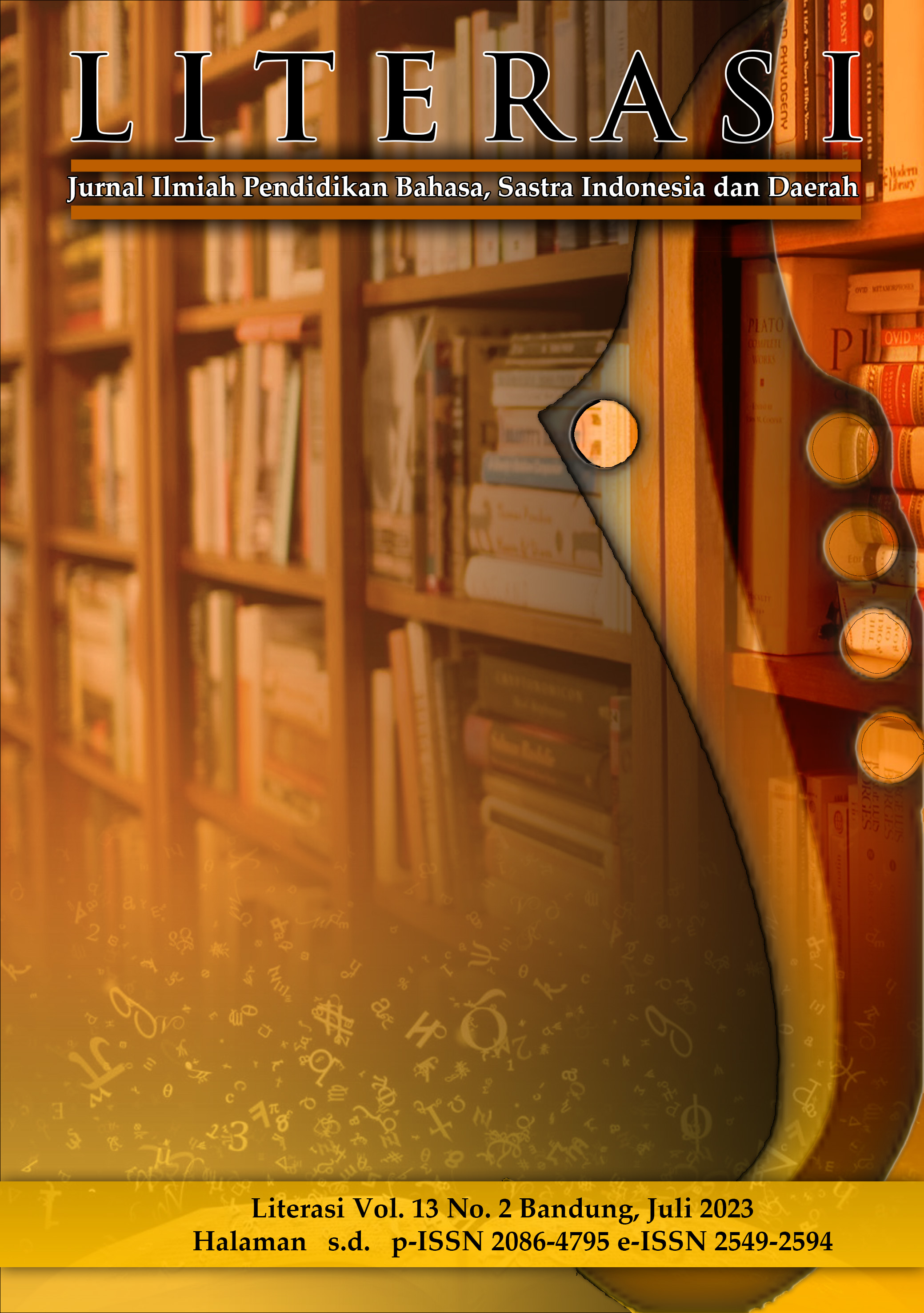BENTUK DAN STRUKTUR SUPERSTISI KATEGORI KEMATIAN DAN ADAT PEMAKAMAN PADA MASYARAKAT MELAYU RUMBAI TIMUR
DOI:
https://doi.org/10.23969/literasi.v13i2.7384Abstract
Superstition is a belief that cannot be proven logically and does not necessarily occur. In this study the authors took one village among the villages in East Rumbai District, namely the village of Tebing Tinggi Okura. This research is also motivated by the researcher's desire to find out the structure and meaning contained in the superstitious East Rumbai Malay community which is formed by the relationship between different life values and beliefs. The purpose of this study is to describe the form and structure of the superstitious categories of death and burial customs in the Malay community in Tebing Tinggi Okura Rumbai Timur Village, Pekanbaru City. The approach to this study uses a qualitative approach while the research method is a qualitative descriptive method with a type of field research. The analysis in this study was carried out in three stages, namely data reduction, data presentation and conclusion. Based on the results of the analysis in this study, there were 27 superstitious forms of death category data and funeral customs. Of the 27 data that has been obtained, 23 data are classified into a two-part structure, namely cause and effect, while the other 4 data include a three-part structure, namely a sign, a change from one state to another (conversion), and a result. The East Rumbai Malay community, especially the village of Tebing Tinggi Okura, has instilled superstitious values in their daily lives, because the use of this superstition can regulate the order of norms in their collective society, especially in death and funeral customs in the East Rumbai Malay community.
Downloads
References
Aisyah, Si. (2020). Makna dan Fungsi Pamali Masyarakat Sukupaser Kecamatan Long Ikis Kabupaten Paser. Jurnal Bahasa, Sastra Dan Pembelajarannya, 10, 139–154.
Amir, A. (2013). Sastra Lisan Indonesia (I; P. Christian, ed.). Yogyakarta: CV ANDI OFFSET.
Astri, N. (2019). Bentuk Reduplikasi Bahasa Indonesia Pada Anak Penderita Autistik Di Yayasan Hijjah Rachmah Nasutio. Jurnal Bahasa Indonesia Prima, Vol. 1, No, 15–22.
Chairani, N. (2014). Makna Kematian Bagi Remaja (Studi Fenomenologi Pada Remaja Pasca Kematian Orang Tua). Jurnal Psikologi, 10, 41–48.
Danandjaja, J. (1997). Folklor Indonesia Ilmu Gosip, Dongeng dan Lain-lain (V). Jakarta: Pustaka Utama Grafiti.
Erni, A. (2021). Makna dan Fungsi Pantang Larang Masyarakat Melayu Peranap di Kecamatan Peranap Kabupaten IndragiriHulu. J-LELC Journal of Language Education, Linguistics, and Culture, 1, 1–6.
Gunawan, K. (2017). Strategi Pemasaran Dalam Meningkatkan Usaha Para Anggota Baitul Maal Wat Tanwil. Jurnal Kajian Ekonomi Dan Bisnis Islam, Volume 10, 234–257.
Herwandi, E. (2018). Pendidikan Nilai Karakter dalam Tradisi Lisan Nyanyi Panjang Bujang Si Undang pada Masyarakat Suku Petalangan Provinsi Riau. GERAM (Gerakan Aktif Menulis), 6, 17–25.
Oktaviani, dkk. (2018). Analisis Kesalahan Berbahasa Indonesia Pada Karangan Eksposisi Siswa Kelas X MIPA (Studi Kasus di SMA Negeri 4 Surakarta). BASASTRA Jurnal Penelitian Bahasa, Sastra Indonesia Dan Pengajarannya, Volume 6 N, 109.
Rian Jamrud, dkk. (2022). Upacara Adat Dina Kematian Pada Masyarakat Di Desa Tutumaloleo Kecamatan Galela Utara Kabupaten Halmahera Utara. Jurnal Holistik, Vol.15 No., 1–18.
Semi, A. (2012). Metode Penelitian Sastra (Keenam). Bandung: Angkasa.
Sugiyono. (2017). Metode Penelitian Kuantitatif dan R&D (Pertama). Bandung: Alfabeta.
Ulya Hasnul, R. (2018). Dimensi Keteraturan Sosial Wanita Hamil dalam Gamitan Supertisi Kubuang Tigo Baleh. KAFA’AH JOURNAL, Volume, 8, 183–196.
Downloads
Published
Issue
Section
License
Copyright (c) 2023 Literasi: Jurnal Ilmiah Pendidikan Bahasa, Sastra Indonesia dan Daerah

This work is licensed under a Creative Commons Attribution 4.0 International License.
Hak cipta artikel yang diterbitkan di jurnal ilmiah dimiliki oleh penerbit, bukan penulis. Hal ini berkaitan dengan koordinasi hak akses untuk cetak ulang atau penggunaan lainnya. Dalam hal ini penerbit mempunyai keluluasaan untuk mempublikasikan artikel sesuai dengan kesepakanan Transfer Agreement (penyerahan hak cipta) antara penerbit dengan penulis.















